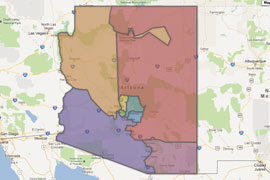Cronkite News has moved to a new home at cronkitenews.azpbs.org. Use this site to search archives from 2011 to May 2015. You can search the new site for current stories.
South Phoenix, Glendale women buck national trend by out-earning men
WASHINGTON – Women earned more than men in just 12 of the nation’s 435 congressional districts in 2011, and one of those districts was in Arizona, according to a new report.
Women in Arizona’s 4th District, which includes southern Phoenix and parts of Glendale and Guadalupe, had a median income of $29,169 in 2011, $111 more than the median income for men there.
By contrast, men statewide made almost $6,500 more than women, according to Census Bureau data analyzed by the National Partnership for Women and Families. The 8th District, covering southeastern Arizona, posted the largest wage gap in the state, with men earning almost $12,500 more than women.
Glendale area officials could not explain the performance of woman earners in the district, but they were happy to claim some credit for it, through efforts of the city and the local chamber of commerce.
“There has been a push by our city government over the past 10 years,” said Don Reinhart, Glendale Chamber of Commerce president. “The city has promoted diversity in the workplace and has been a leader in the West Valley.”
But while women in the 4th District did well compared to men there, the report also showed median incomes in the district were the lowest in the state. In the other 11 districts nationally where women out-earned men, the median incomes were also the lowest or among the lowest in their states.
Nationally, the wage gap has been unchanged for about a decade, with women earning 77 cents for every dollar earned by men, according to the National Partnership for Women and Families. The group examined 2011 wages by congressional district to see how the pay disparity played out on a state level.
Data such as this can “better enable them (women) to fight wage discrimination,” said Sarah Crawford, the organization’s director of workplace fairness. While the partnership knew a wage gap existed, Crawford said she didn’t expect it to be so sweeping.
“I think ultimately what stands out is that you can look around the country and in 97 percent of all districts men bring home more than women,” Crawford said. “This one district in Arizona is one of the outliers.”
The Census Bureau numbers showed that some of the jobs where women made more than men in the 4th District included health care, sales and office occupations. Reinhart noted that Glendale contains a large medical community and also has one of the largest city government systems in the West Valley, areas where officials have tried to create higher-paying jobs and promote diversity.
Health care could be part of the reason that the wage gap is so close in the 4th District, said Lee McPheters, director of the JPMorgan Chase Economic Outlook Center at the W.P. Carey School of Business.
“One of the areas in the Arizona economy that has done well right through the recession was health care,” McPheters said. “It supports occupations, tends to be a part of the economy that pays higher than average, and employs more women than average.”
The wage gap can be narrowed if women find their way into those positions, McPheters said. But he noted that, while that may close the overall gap, it does not address the particular issue of men and women in the same job where “women are paid less.”
While there are good jobs, and good wages, to be found in health care, McPheters said overall incomes in the district are likely being dragged down by other, not-so-lucrative jobs.
“The composition might be more undocumented workers, it might be a more mobile district,” McPheters said of the 4th District having the lowest median salaries in the state.
Reinhart said city and chamber officials continue to work to bring higher-paying jobs to the area. But for now, he believes the numbers are accurate and that women are doing relatively well compared to men in the area.
“If you add it all up, it probably isn’t surprising, with the emphasis on diversity and creating higher-paying jobs by the city’s government and chamber of commerce,” Reinhart said.







